
Austracantha is a genus of spider with a single species, Austracantha minax, commonly known as the jewel spider or the Christmas spider. It is a member of the family Araneidae and is endemic to Australia. They are relatively small spiders, reaching a maximum total body length of only around 12 mm (0.47 in) for females, and 5 mm (0.20 in) for males. Their abdomen has six distinctive projections ("spines") that makes them easy to identify. They are predominantly a shiny black, with variable white, yellow, and orange patterns. Melanistic forms also occur during autumn. They are facultatively gregarious, and can be found in large aggregations of overlapping orb webs. They feed on small flying insects that get entangled in their webs. They are harmless to humans, though the webs can be a nuisance for bushwalkers. They are most abundant during the summer months.

The spider species Tegenaria domestica, commonly known as the barn funnel weaver in North America and the domestic house spider in Europe, is a member of the funnel-web family Agelenidae.

The nursery web spider Pisaura mirabilis is a spider species of the family Pisauridae.

Phidippus californicus is a species of jumping spider. It is found in the southwestern United States and northern Mexico.
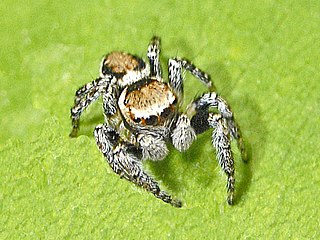
Evarcha falcata is a species of 'jumping spiders' belonging to the family Salticidae.

Evarcha arcuata is a species of jumping spiders with a palearctic distribution.

Maevia inclemens or the Dimorphic Jumping Spider is a relatively common and colorful jumping spider of North America. In the males there are two forms, a very rare phenomenon in zoology. These use different courting displays, and differ in appearance: the "tufted" morph has a black body and pedipalps ("palps"), three black tufts across its "head", and pale legs; and the "gray" morph has black and white stripes all over its body and legs, orange palps, and no tufts. However, each form accounts for 50% of the adult males, and they are equally successful in mating. A female of Maevia inclemens is 6.5 to 8.0 millimetres long, while males are 4.75 to 6.50 millimetres long.

Carrhotus xanthogramma is a species of jumping spider belonging to the family Salticidae.
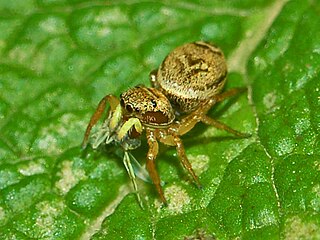
Heliophanus tribulosus is a species of 'jumping spiders' belonging to the family Salticidae.
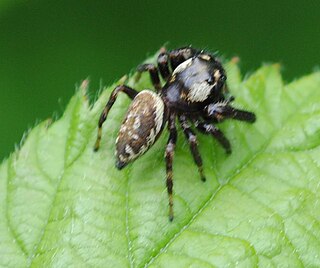
Macaroeris nidicolens is a species of jumping spider that occurs from Europe to Central Asia.
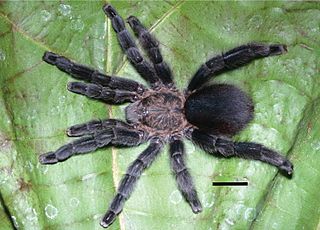
Pachistopelma bromelicola is a species of tarantula, contained within the Aviculariinae subfamily. It is endemic to Brazil.

Langona pilosa is a species of jumping spider in the genus Langona that lives in Namibia. The male was first described by Wanda Wesołowska in 2006 and the female in 2011. The spider is small with a cephalothorax between 2.2 and 3.1 mm long and a abdomen between 2.1 and 3.5 mm. The female is larger than the male. The spider has a brown carapace that has two white stripes on its back, a large dark patch on its yellowish abdomen, a black eye field and the toothless chelicerae typical of the genus. The male can be distinguished from others in the genus by the existence of tufts around the palpal bulb, after which it is named, and the very long and thin tibial apophysis. The female has copulatory organs that resemble Langelurillus ignorabilis but differ in the design of the seminal ducts.
Nigorella aethiopica is the type species of the genus Nigorella. A jumping spider that lives in Ethiopia and named in honour of the country in which it is found, it was first described in 2008 by Wanda Wesołowska and Beata Tomasiewicz. The spider is larger than others in the species with a cephalothorax that is between 4.1 and 4.8 mm long and an abdomen that is between 4.3 and 5.6 mm long. The carapace is generally brown and hairy, although the male is darker. While the male abdomen is marked by a light stripe on the topside and dots underneath, the female abdomen has a pattern of a light stripe and patches on the top and dark stripes on the bottom. As well as the larger size, there is a split at the end of the appendage on the pedipalp tibia that marks out the male, and the female has longer seminal ducts and thinner spermathecae than others in the genus.

Aelurillus desertus is a species of jumping spider in the genus Aelurillus that is endemic to the United Arab Emirates. It was first described in 2010 by Wanda Wesołowska and Antonius van Harten. Initially only the male was described, the female following ten years later. The spider was originally classified in the genus Rafalus but was moved to its current genus at the same time as the female description was first published. The species is medium-sized with cephalothorax that is between 2.8 and 3.3 mm long and a abdomen that is between 2.8 and 4.8 mm long. The female is larger than the male. The carapace has a distinctive stripe. The female has three darker spots on the abdomen. The species can be distinguished by the existence of a triangular lobe on the palpal bulb on the male and the way that the copulatory openings are close to the rear of the epigyne on the female.

Langona bethae is a species of jumping spider in the genus Langona that lives in Botswana and Zimbabwe. The male was first described in 2011 by Wanda Wesołowska and Meg Cumming. The spider is large with a cephalothorax between 2.6 and 3.5 mm long and a abdomen between 2.2 and 4.4 mm. The female is larger than the male. The spider has a brown carapace that has two white streaks on the thorax a black eye field. It has the toothless chelicerae typical of the genus. It can be distinguished by its abdominal pattern, which has a yellow streak of an irregular shape. The male has a hidden embolus that is shorter than that on the related Langona pilosa. The female has copulatory organs that resemble Langelurillus ignorabilis but differ in the design of the seminal ducts.

Langona zimbabwensis is a species of jumping spider in the genus Langona that lives in Zimbabwe. The male was first described by Wanda Wesołowska and Meg Cumming in 2011. The female has not been identified. The spider is large with a cephalothorax between 2.9 and 3 mm long and an abdomen between 2.5 and 2.6 mm. The spider has a brown carapace with two faint white stripes on its back and a black eye field. It has the toothless chelicerae typical of the genus. It has a long and thin tibial apophysis. The spider can be distinguished from others in the genus by its distinctive pattern of 12 white spots, consisting of six pairs, and a black stripe on its abdomen.

Langona sabulosa is a species of jumping spider in the genus Langona that lives in Namibia. It was first described in 2011 by Wanda Wesołowska. The spider is large with a cephalothorax between 2.2 and 4 mm long and a abdomen between 2.2 and 4.5 mm. The female is noticeably larger than the male and has a very different shape to its much larger abdomen, being more heart-shaped than oval. It has the toothless chelicerae typical of the genus. The abdomen has a large leaf-like pattern, which differentiates it from other species in the genus, as can the yellowish-orange colour of the pedipalps on the male. The female has a unique epigyne that led Wesołowska to question where it should be allocated in the subtribe Aelurillina.
Plexippus lutescens is a species of jumping spider in the genus Plexippus that lives in Namibia and Zimbabwe. It was first described in 2002 by Wanda Wesołowska. Only the male has been described. In 2017, Jerzy Prószyński declared it should be reclassified as the spider has a different palpal bulb to others in the genus, but this was not been undertaken. It is a medium-sized spider, with a cephalothorax typically 3.3 mm (0.13 in) long and an abdomen that is 4 mm (0.16 in) long. The dark brown carapace has three white stripes and the reddish-brown abdomen has a single stripe of lighter brown. The spider has a short tibial apophysis and thin embolus. It lacks the lateral lobe on the palpal bulb that is visible on other species in the genus.
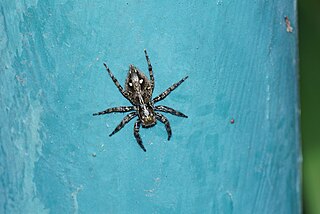
Plexippus minor is a species of jumping spider in the genus Plexippus that lives in the United Arab Emirates. The male was first described by Wanda Wesołowska and Antonius van Harten in 2010 and the female in 2020. The spider is medium-sized with a cephalothorax between 3.1 and 3.8 mm long and an abdomen between 3.3 and 4.1 mm long. It has a shape and colouring typical of the genus. The male has a orange carapace while the female is brownish-fawn. The copulatory organs distinguish it from related species, particularly the male's shorter embolus and tibial apophysis and the female's wide pocket on its epigyne.

Eris militaris, known commonly as the bronze jumper or bronze lake jumper, is a species of jumping spider, belonging to the Salticidae family. It is found in the United States and Canada within both suburban and rural areas. The male and female of this species can be differentiated from their size or by the coloration on their cephalothorax and abdomen. The females have a lighter cephalothorax a slightly darker abdomen with white spots. They are active in the autumn and winter season and can be found in sheltered areas within vegetation. They can also be found living within apple orchards, where insecticides may be present, which can potentially effect or alter their personality and behavior. Their diet consists of small insects, almost anything they can hold.


















